Last year, about 11 million people visited the city of Memphis. That’s roughly the population of Cuba or the American state of Georgia. There’s no official tourist season in Memphis, really, like spring break or summertime at beaches. But there are some high tides — Elvis Week and Memphis in May (MIM), for example.
Some 265,000 people came to the east bank of the Mississippi River in May last year for the Beale Street Music Festival, World Championship Barbecue Cooking Contest, 901 Fest, and the Great American River Run. About 60 percent of those visitors came from outside of Shelby County — from all 50 states and from all over the world.
May is easily the biggest blip on the Memphis tourism radar. But Robert Griffin, marketing director for MIM, said that’s largely because the festival is a month long with many diverse events, adding that, “Elvis Week is huge, but it’s only a week.”
Hospitality is the bedrock of the tourism industry. And as I found out in reporting this story, those in the Memphis tourism industry are also hospitable to each other. The competition is healthy, but the players are cooperative, not cutthroat. That’s largely due to the many different types of tourists who come here and the many different experiences Memphis can offer them. There’s plenty for everyone, it seems.
Memphis tourism was a $3.2 billion industry in 2015, according to the latest numbers from the U.S. Travel Association.
About 67,800 people are employed in the “leisure and hospitality” business in Shelby County, according to the freshest figures (April 2017) from the United States Bureau of Labor Statistics. Tourism is the fifth-largest employer in Shelby County, only behind industries transportation (read: FedEx Corp.), education, health care, government, the very-broad “business services” category.
Where Are the Tourists?
As a Memphian, you probably think about Beale Street, Graceland, Bass Pro Shops at the Pyramid, and those riverboats — places you may not go to regularly. Intellectually, you know those places are filled with tourists, but as we go about our workaday world, most of us rarely see those folks. When my folks came in town for a visit last year, my stepfather wanted to see Bass Pro, so off we went.
We stood by the gleaming glass fish tank by the kids’ section, along with 40 or so other visitors, watching as catfish, bass, and crappie swim around. Then a voice broke from the ether.
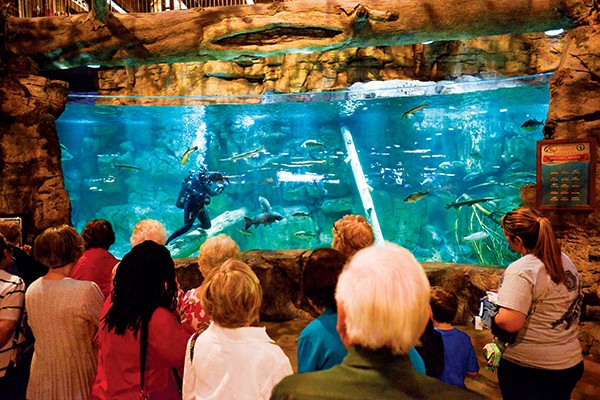
Bass Pro
“Hello, how are you today?”
A man in a black dive suit had climbed into the tank and was waving and talking to us from behind his swim mask. We went from amused to entranced. The man fed the fish from a plastic bag, describing the different species that were swimming around him and nipping at his fingers.
“Thanks for joining me today,” the man said, wrapping up his show. “Let me ask, how many of you are from out of town?”
Every hand but mine went into the air. It was 10:30 a.m. on a Wednesday. Ordinarily, I’d be at The Memphis Flyer office, but on this day I had found the tourists — and I was one, myself.
“When you got a glimpse of the visitor economy that day at Bass Pro, I’m sure you went ‘Wow!,'” said Kevin Kane, president of the Memphis Convention and Visitors Bureau. “That’s when it hits home: There’s a lot of power in [tourism]. It’s a $3.2 billion industry in Memphis. It’s a big deal. It’s important.”
That’s why we’re taking a closer look at the fun-having industry here. (And, look, y’all, I promise I had no idea that this week is National Travel and Tourism Week. Seriously.)
The American Dream Safari
Tad Pierson drives a time machine, a 1955 Cadillac, and he’ll pick you up from your hotel.
That’s how it works with his American Dream Safari tour company. Since 1996, Belgians, Brazilians, Taiwanese, Texans, and a whole bunch of Brits, and hundreds of others from around the U.S. and the world have piled into Pierson’s Caddy to see history through its windows and, perhaps, get a few “psychic souvenirs” (more on that later).
“It’s a beautiful town to cruise around in,” Pierson said, “Because a lot of subjects come up.”
Pierson’s clients know they’re getting a general tour of Memphis, but those conversations easily swing to the city’s music, its place in the civil rights movement, the Civil War, and, of course, Elvis.
Pierson hones in on their interests and tailors the tours to his customers. While he hits the typical “must-sees,” he also takes visitors to some out-of-way spots — like the place where Johnny Cash met the Tennessee Two, or to B.B. King’s first house in Memphis.
Pierson calls what he does “anthro-tourism.” It’s the same idea as eco-tourism, he said, but with history as the focus. He hopes that the upsurge of new development here won’t spoil the city’s most essential asset: “Memphis is real,” Piersaon said. “People come here for that reason. They don’t come here because it’s, say, an artificially rebuilt waterfront that rips them off. It’s an authentic scene here, and we have to protect that.”
Pierson will also send you home with a bit of that Memphis real-ness. Instead of tchotchkes or a T-shirt, Pierson hopes his clients go home with a powerful Memphis memory, like, say, the aroma of barbecue wafting over the parking lot at Cozy Corner.
“These psychic souvenirs are just moments that go by the window of the car and you’re like — ah! — I gotta remember that one forever,” Pierson said.
Our “Big Hooks”
Kane, who is basically the mayor of Memphis tourism, would rather talk about our city’s “big hooks” rather than give some clinical listing of our top, most-visited attractions.
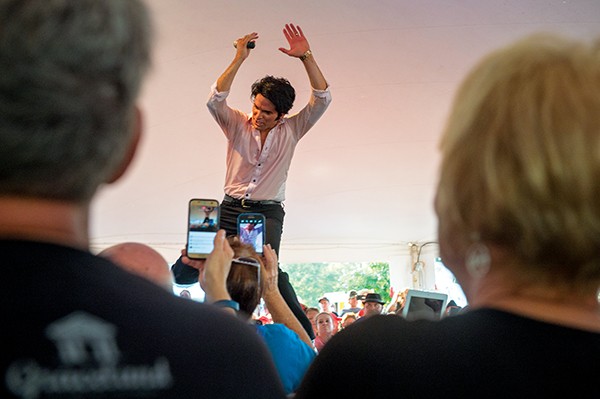
Graceland
Music, he said, is without a doubt our “biggest hook” here, whether it’s Graceland or Sun Studios or the Stax Museum or Beale Street, or the Center for Southern Folklore or the Rock ‘n’ Soul Museum or the Blues Hall of Fame — all places Kane cited off the top his head.
“I think our music heritage gives us a cool factor that only a few cities can boast about,” Kane said. “Memphis, Nashville, Chicago, Kansas City, and Austin — only a handful of cities can lay claim to music and do it legitimately.”
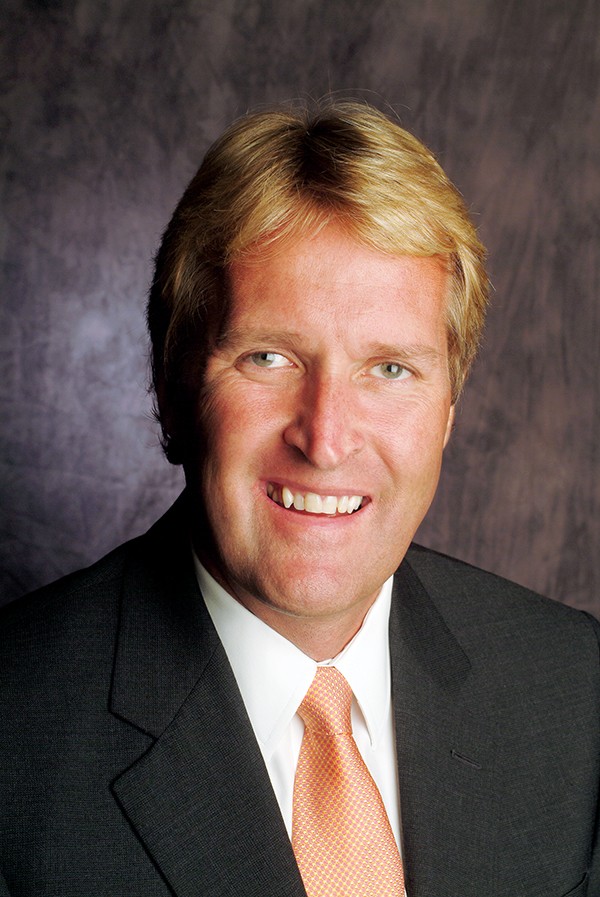
Kevin Kane
Kane thinks another big hook for Memphis is its Southern culture and, largely, that means food. Barbecue is likely the city’s second-largest cultural export, after music. That’s evidenced by lines that stretch out the door at Central BBQ’s downtown location or the fact that the Rendezvous’ waiting area is big enough to house a bar. But, also, consider that the MIM barbecue contest drew 37,146 tourists last year, who spent about $17 million while they were here.
But Kane notes that Memphis’ culinary scene is growing beyond barbecue. Chefs here are regularly opening diverse new spots and further defining the Memphis dining landscape.
“The Southern product we’re able to roll out — with Southern art and food and friendliness — is huge for us,” Kane said.
The big hooks for Memphis tourism also include “family fun stuff” like the Children’s Museum or the Memphis Zoo. It’s also important historical attractions such as the National Civil Rights Museum, and outdoor attractions like Shelby Farms Park and Big River Crossing, Kane said.
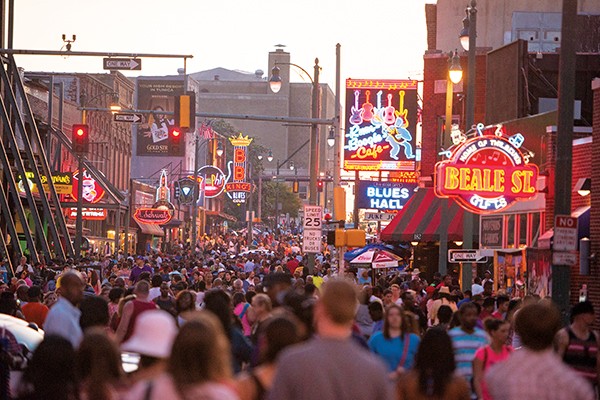
Beale Street
For the record, Memphis’ top 10 tourist attractions in 2015 were, in order, by attendance: Beale Street (5 million visitors), Bass Pro (2 million), Agricenter International (1.3 million), Memphis Zoo (1.1 million), Overton Square (1 million), Memphis Grizzlies (820,000), The Peabody Grand Lobby (750,000), Golf & Games Family Park (634,000), Mike Rose Soccer Complex (620,000), and Graceland (600,000). These figures are according to the Memphis Business Journal‘s 2016-2017 Book of Lists.
A Tour of Possibilities
Carolyn Michael-Banks knows her tour is nontraditional — and it may even make some people uncomfortable. But her goal in founding A Tour of Possibilities was to “share the historical and cultural gems that African Americans have contributed to Memphis.” It does so with stops at Beale Street, Robert Church Park, Slave Haven Underground Railroad Museum, Soulsville, Stax, and more.
Michael-Banks spent years doing tours for other companies in Philadelphia and Washington, D.C. She included African-American history in those tours, as well, but her bosses felt it made some uncomfortable.
“The thing about history is that there are parts of it that are definitely uncomfortable,” she said. “But just because they are uncomfortable doesn’t make them not exist. Our tag line [at her former company] was ‘reliving history.’ I felt compelled to relive it completely and [my company] is doing that now.”
Hop on Michael-Banks’ van (which she calls the Van of Possibilities) and you may find Brits, other Europeans, Australians, and Americans, many from Chicago, Texas, and California, she said. People from all over, except Memphis (more on that later).
Her tour is designed to stop at a place “that will probably make you feel uncomfortable” but leave within 10 minutes and head off to something else. She’s not doing a documentary, she said, and she’s not a professor giving a lecture. “So, I believe there’s a way to blend history without sugar-coating what is difficult,” said Michael-Banks. “You go through a rollercoaster of emotions, and that is intentional.”
Having a small van (10 passengers) allows her clients to feel comfortable enough to express themselves. Most respond positively to the tour, she said. And Memphians might change their minds about their own town if they’d come along.
“If Memphians actually got why 11 million come here every year, they would feel a little different about themselves,” she said. “They wouldn’t be saying, ‘Oh, no, you don’t want to come here.’ I’m working on trying to get to them to say, ‘Oh, you have to come here.'”
How’re We Doing?
Memphis has held steady at number two in Tennessee tourism for many years. Nashville is a regional tourism powerhouse, pushed farther and faster now by the newly built, $623-million Music City Center convention center.
Kane said he uses two barometers to gauge the health of Memphis’ tourism industry: attraction attendance and occupancy room rates at area hotels and motels. The city is healthy, he said, and its future is “very, very bright.”
Last year, about five million tickets were sold for paid attractions here like the zoo, museums, and other attractions. Hotel occupancy spiked 10 percent three years ago, Kane said, and the figure has been slightly up or flat ever since (but it hasn’t receded) from about 5.4 million paid room nights per year.
Kane bemoaned some near-misses that could’ve boosted tourism, such as not attracting the Tanger Outlets to the Pinch District near the Cook Convention Center. But an update to the Convention Center is in the works. Renovation construction will begin there as soon as September, Kane said. It’s a $60-million facelift project aimed at modernizing the space with a “total interior and exterior renovation.”
The project will bring functionality to the building, including more loading docks with easier access. It’ll also bring aesthetic upgrades, such as views of the Mississippi River and what Kane calles a “21st-century feel” to the inside of the building.
“We’re not going to build the Music City Center; we don’t have the money for that,” Kane said. “We are going to make a substantial investment in our convention center, and I think it’ll pay huge dividends for us.”
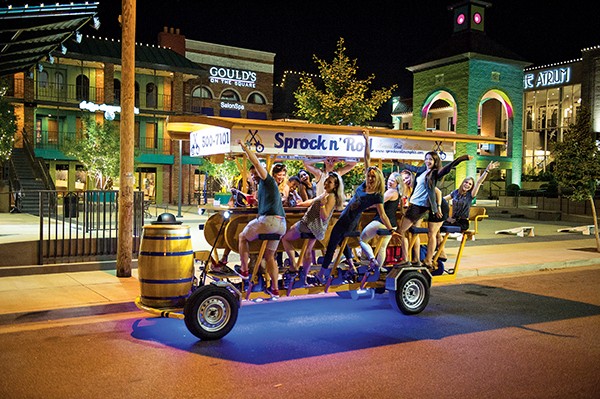
Sprock N’ Roll
Sprock N’ Roll
Call it a pedal bar, a party bike, a rolling tavern, a bar bike, or something else, but Ashley Coleman wants you and your friends to come try it.
Sprock N’ Roll brought their party bike (let’s just call them party bikes, okay?) to Memphis two years ago. Since then, hundreds have mounted the oversized bike seats and pumped the mobile bars around downtown or Midtown.
Not clear on the concept? Imagine a small bar with five bar stools on each side, a bench in the back — under a tin roof and on four wheels. A bartender hangs out in the middle, and a driver mans the steering wheel and brakes at the front. You and your friends provide the power by pedaling. The more people, the easier the pedaling.
Coleman said the company’s most popular tours are two-hour pub crawls. But the company also offers an “Artsy Fartsy Tour” (which begins at the Art Project), progressive dinner tours, and brunch tours.
While most of Memphis’ tourists stay downtown, Coleman said she tries to lure them to Midtown with a tour that rolls between Overton Square and Cooper-Young (and several bars en route). Coleman bills the tour as “where the locals like to go.”
“Some aren’t coming for the Beale Street party,” Coleman said. “They want to see other cool parts of town. Many [tourists] aren’t familiar with Midtown. We take them off Cooper down Rembert, and everyone enjoys seeing the houses. They’ll say, ‘We love this part of town!'”
Coleman said it’s likely that more locals ride her party bikes than tourists, but plenty of tourists still ride through Midtown, she said, remembering a time a group of Australians rode down Cooper with a group of Iowans.
“They end up staying in that part of town,” Coleman said. “They’ll get off the bike and explore some more. It’s a great way for us to get the tourists to Midtown and get them spending some money there.”
May is a big season for Sprock N’ Roll, Coleman said, noting that they have to work to make sure there’s enough availability to meet the demand.
“It’s just a fun way to see the city.”
The Real Deal
Attracting more conventions and conferences has long been a goal of the CVB, and a theme of many of the group’s annual meetings. The renovated convention center is supposed to help with that, but Kane said the convention center still needs a large, nearby, full-service hotel. “We’ve got the Sheraton, the Peabody, the Hilton out East and, now, the Guest House at Graceland, but none of them are within walking distance of the convention center,” Kane said.
Kane added that another missing piece of the tourism puzzle is an indoor sports complex. Kane and the CVB were major supporters of a plan formulated a few years ago that would transform the Mid-South Fairgrounds into a mammoth youth sports complex, with sports fields, indoor arenas, a hotel, and big-box retailers.
“We’re ready for that type of a complex somewhere in Memphis,” Kane said. “I don’t know if it’ll be at the Fairgrounds or if it’ll be out in Cordova or downtown. I don’t know where the darned thing will be located. But we’re really aggressively working on that now.”
Kane, who has spent more than 25 years selling the Memphis experience to potential visitors around the globe is, indeed, bullish on Memphis tourism. For him, there is a “cool factor and an intrigue and mystique about Memphis.” It’s also authentic, he said.
“I don’t know if you saw it that day you were in Bass Pro, but overwhelmingly most of the visitors who come here are impressed by the friendliness of our people,” Kane said. “They genuinely find that Memphis is real and it’s not manufactured, not some made-up experience. It’s a real, natural, real-deal type of experience. So, we’ve kept it real, and people appreciate that.”